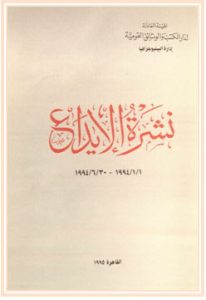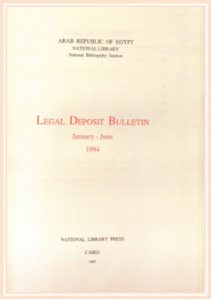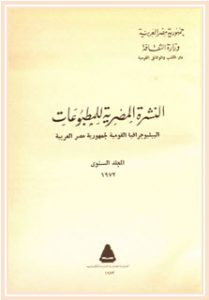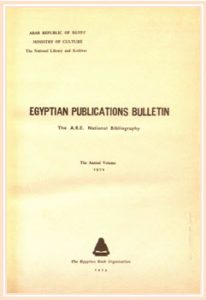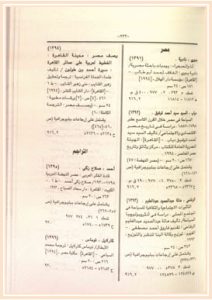
Introduction
Bibliography has a long history in the Arabic speaking world, dating back to the 10th century with The Fihrist of al-Nadīm. In the case of Egypt, bibliography was a personal, rather than institutional, endeavor until the National Library of Egypt issued Egyptian Publications Bulletin in 1955. Efforts by individual bibliographers to create comprehensive lists of Egypt’s publishing output before 1955 seem almost herculean due to the diffusion of record keeping. For example, bibliographer Ahmad Muhammad Mansur consulted nine academic and cultural institutions, and seven different catalogs and indexes in order to document the period immediately preceding the national bibliography. Networking and collaboration has been critical to this work.
Although the National Library was established in 1870, the new copyright law in 1954 finally prompted the Library to issue a national bibliography. This new law mandated that publishers submit five copies of a work to the National Library within six months of publication. Egyptian Publications Bulletin, later known as Legal Deposit Bulletin in 1974, only includes works deposited in the Egyptian National Library. It is the most comprehensive record we have of Egypt’s publishing output, but not perfect. Egypt’s copyright law has never been rigorously enforced, partly because its severe restrictions make enforcement unrealistic. Government publishing houses, therefore, were more likely to comply with copyright law than small private presses.[1] In some cases, Accessions List, Middle East, published by the Library of Congress’ Cairo Field Office between 1963 and 1993, may include materials not found in the national bibliography.[2]
Sources that describe the history of Egyptian bibliography are limited. Yusuf As’ad Daghir’s article, “Wad’al-Bibliyughrafyafi al-‘Alam al-‘Arabi” (Al-Adib, vol. 34 Vol. 34 Issue 10, p20-26, 1958), begins with a helpful historical overview of Arabic bibliography, and then briefly discusses the historical milestones of each country, including Egypt. Mansur’s bibliography, Index of Egyptian Publications: 1940-1956, gives a detailed account of the history of Arabic and Egyptian bibliography in its introduction.
[1] Klein 2003, pg. 163
[2] Hirsch 2007, pg. 99
Egyptian Publications Bulletin
- (al-Nashrah al-Miṣrīyah lil-maṭbū’āt/النشرة المصرية للمطبوعات)
- Cairo: National Library Press, 1955-1974.
- OCLC: 3076060
- UIUC Edition
- al Nashrah al Misriyah lil Matbuat: 1955-1972
- Call number: 015.52 N17
- School books volume missing from 1966-67 edition in UIUC collection
Legal Deposit Bulletin (Nashrat al-Ida’/ نشرة الايداع )
- Cairo: National Library Press, 1974-
- OCLC: 3735020
Legal Deposit Bulletin: Children’s books
- (Nashrat al-ida’: Kutub al-atfal wa-al-nashiah)
- Cairo: National Library and Archives, 1995-
- OCLC: 43826529
- UIUC Edition
- Nashrat al Ida’: 1996-2004
- Call Number: Z3651 .N36
History
Despite its establishment in 1870, the Egyptian National Library (Dar el-Kotob/ دار الكتب ) did not issue its first national bibliography until 1955. A legal deposit law was in effect as early as the 1940s, but the new copyright law in 1954 prompted the National Library to compile the deposited works into a single publication, Egyptian Publications Bulletin.
The new copyright law, which mandated that publishers submit five copies of a work to the National Library within six months of publication, was one of the many changes occurring in the publishing industry after the 1952 revolution. The new nationalist government took renewed interest in publishing, recognizing its power to cultivate Egyptian and Arab nationalism in the public. Many of the large publishing houses were nationalized, and private publishing severely reduced. Heightened book production and bureaucracy resulted in book duplication, warehouses packed with unsold books, and the main government publishing office falling into extreme debt. In 1972, all book activities were consolidated into one government office, The General Egyptian Book Organization (GEBO/ الهيئة المصرية العامة الكتاب), including the National Library.
The title of Egypt’s national bibliography changed to Legal Deposit Bulletin in 1974. The bibliography began to transition to the new name starting in 1969, when it changed from a quarterly to monthly publication. The monthly publications were called Monthly Legal Deposit Bulletin (Nashrat al-Ida’ al-Shahriyah/ نشرة الايداع الشهرية). The annual compilation continued under the title Egyptian Publications Bulletin until 1974.
Legal Deposit Bulletin is available electronically on Dar el-Kotob’s website as a PDF. (http://www.darelkotob.gov.eg/edaa.aspx). Editions of Egyptian Publications Bulletin from 1955-74 are also available electronically through the HathiTrust Digital Library. Although copyright restricts access to full text, the text is searchable, and can trace word frequency and page number.
Variances between editions
Sections
Editions between 1955 and 1969 organize bibliographic entries into two main sections: the main section and children’s books. Government documents appear as a separate section after 1969. Children’s books appear as a separate publication starting in 1995 (Legal Deposit Bulletin: Children’s Books).
Entries
Entries were arranged alphabetically by title until 1969. After 1969 the main access point of entries became author name. Authors living after 1800 appear under their last name, while authors living before 1800 appear under the name they are most known by. Dewey Decimal numbers were also included in entries after 1969. ISBN numbers did not appear in entries until after 1975, but can also serve as an access point in a search.
Indexes
Title, author, and subject indexes appear in editions after 1960, but not before (including the 1955-1960 edition). A publisher’s index appears after 1969.
Search Tip
Use the transliterated rather than English title when conducting a title search, but do not include hyphens or apostrophes.
Arrangement
Works in all sections are arranged according to the Dewey Decimal Classification system. Subject headings are as follows:
- General Works
- Philosophy and Psychology
- Religion
- Social Sciences
- Language
- Science
- Technology (Applied Sciences)
- Arts
- Literature
- History, Geography and Biography
Timeline
- 1954: Creation of national copyright law, which mandates that publishers submit five copies of a work to the ·National Library within six months of publication.
- 1955: The first publication of Egyptian Publications Bulletin. It is issued on a qua1terly basis.
- 1968: Copyright law revised
- 1969: Bibliography is issued on a monthly basis under the title Monthly Bulletin for Legal Deposit. Its annual publication continues under the narne Egyptian Publications Bulletin.
- 1973: Egypt adopts the Inte1national Standard Bibliographic Description (ISBD)
- 1974: The bibliography changes its title to Legal Deposit Bulletin, and is issued inquarterly installments.
- 1975: Egypt adopts ISBN numbers
- 1992: Copyright law is revised to standardize deposits and strengthen copyright protection rights of the author
- 1996: Bibliography issued on a monthly basis
- 1999: National bibliography mechanized
References
Hirsch, David. “Middle Eastern Collection Development in Academic Libraries.” Building Area Studies Collections, ed. Dan Hazen and James Henry Spohrer. Wiesbaden: Harrassowitz, 2007.
Klein, Menachem. “Egypt’s Revolutionary Publishing Culture-1952-62.” Middle Eastern Studies, Vol. 39, No. 2 April 2003, pp.149-178.
